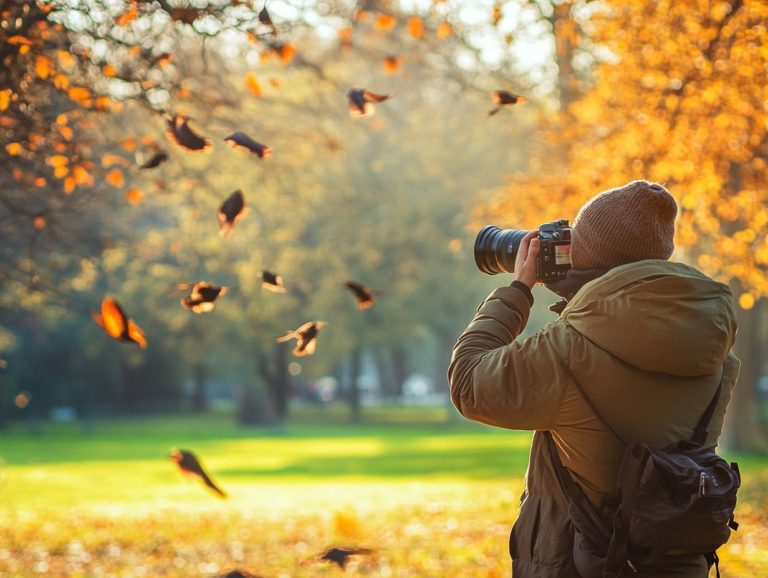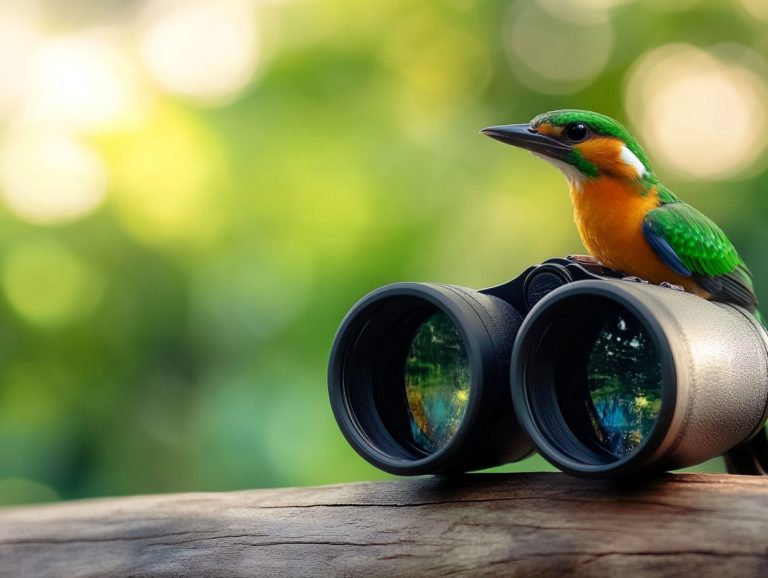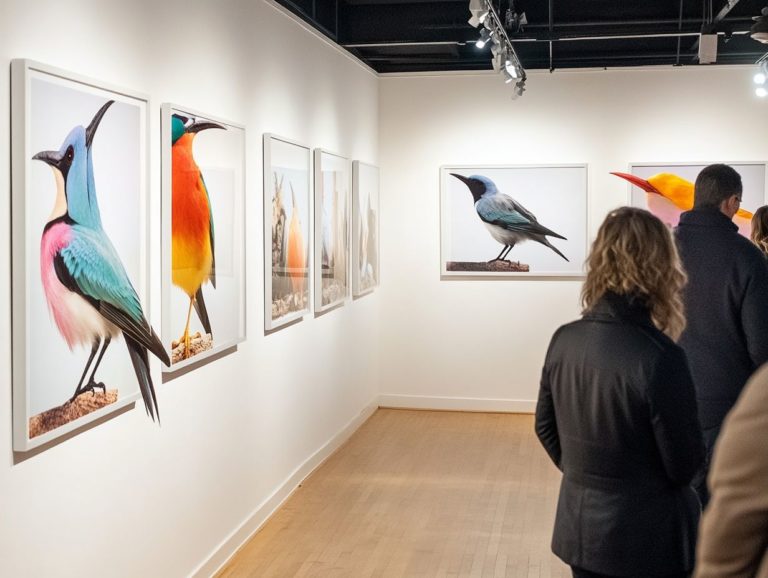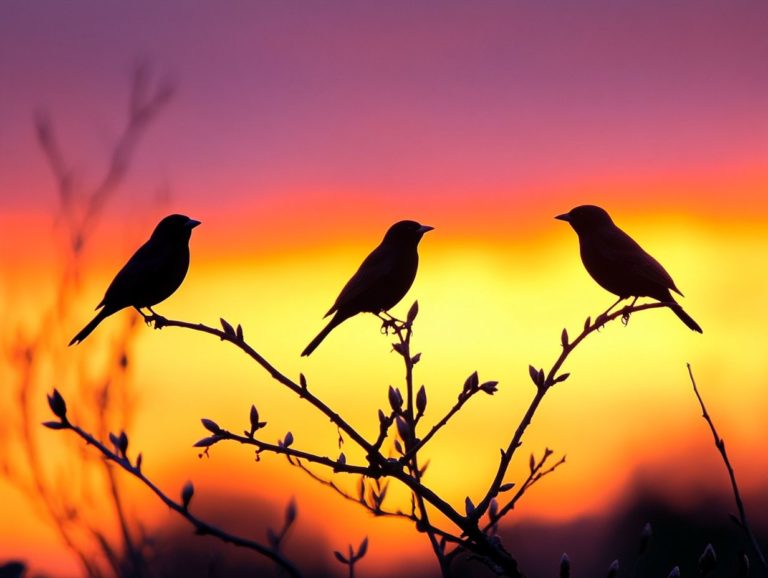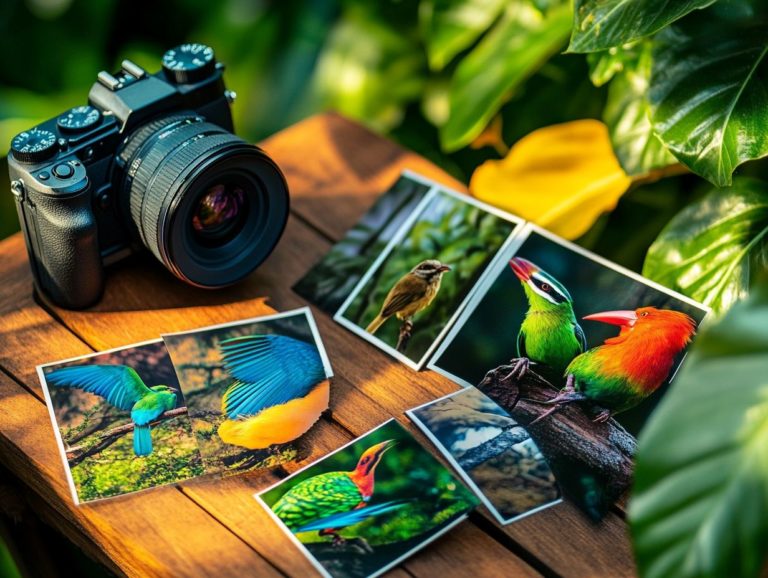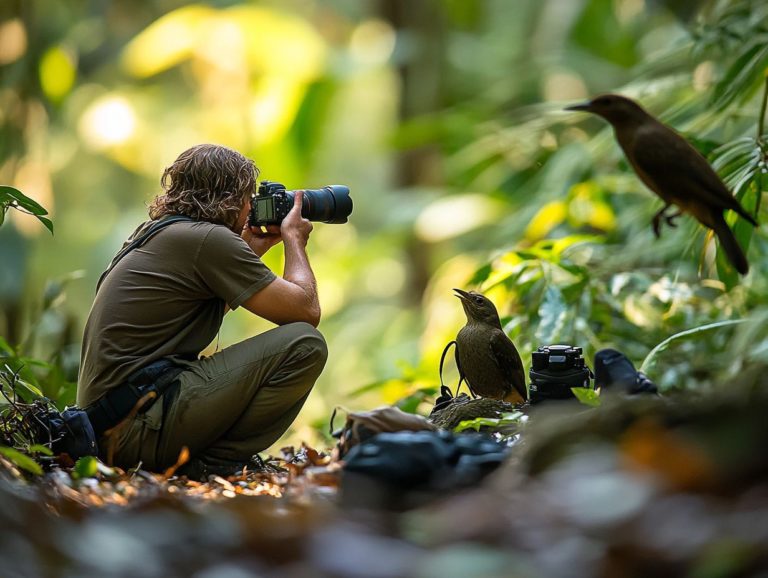Affordable Cameras for Bird Photography
Bird photography is a captivating way to celebrate the beauty and grace of our feathered friends. The good news is that it doesn t have to cost a fortune!
You re in for a treat! This guide gives you everything you need, providing insights on essential camera features and budget-friendly options that still deliver stunning results.
Explore top cameras specifically designed for bird enthusiasts, along with tips for capturing breathtaking photos and techniques to elevate your skills.
Whether you’re just starting out or seeking to refine your craft, you’ll find a wealth of resources at your fingertips! Grab your camera and get ready to capture the beauty of birds!
Contents
- Key Takeaways:
- 2. Factors to Consider When Choosing a Camera for Bird Photography
- 3. Top 5 Affordable Cameras for Bird Photography
- 4. Why These Cameras Stand Out for Bird Photography!
- 5. Sample Images Taken with Each Camera
- 6. Additional Equipment and Accessories for Bird Photography
- 7. Tips and Techniques for Capturing Great Bird Photos
- 8. How to Edit and Enhance Bird Photos
- 9. Common Mistakes to Avoid in Bird Photography
- 10. How to Practice and Improve Your Bird Photography Skills
- 11. Comparing Affordable Cameras to High-End Options
- What Makes a Camera Ideal for Bird Photography?
- What Are the Key Features to Look for in a Camera for Bird Photography?
- What Are Some Budget-Friendly Brands for Bird Photography?
- How Can One Get Started in Bird Photography without Breaking the Bank?
- What Are Some Common Challenges in Bird Photography and How to Overcome Them?
- How Can One Make the Most of Their Affordable Camera for Bird Photography?
- Frequently Asked Questions
- What are some affordable cameras for bird photography?
- What is the best budget-friendly camera for capturing birds in flight?
- Do I need a long lens for bird photography?
- What is the advantage of using a mirrorless camera for bird photography?
- Are there any affordable cameras with good image quality for bird photography?
- Do I need any special features on a camera for bird photography?
Key Takeaways:
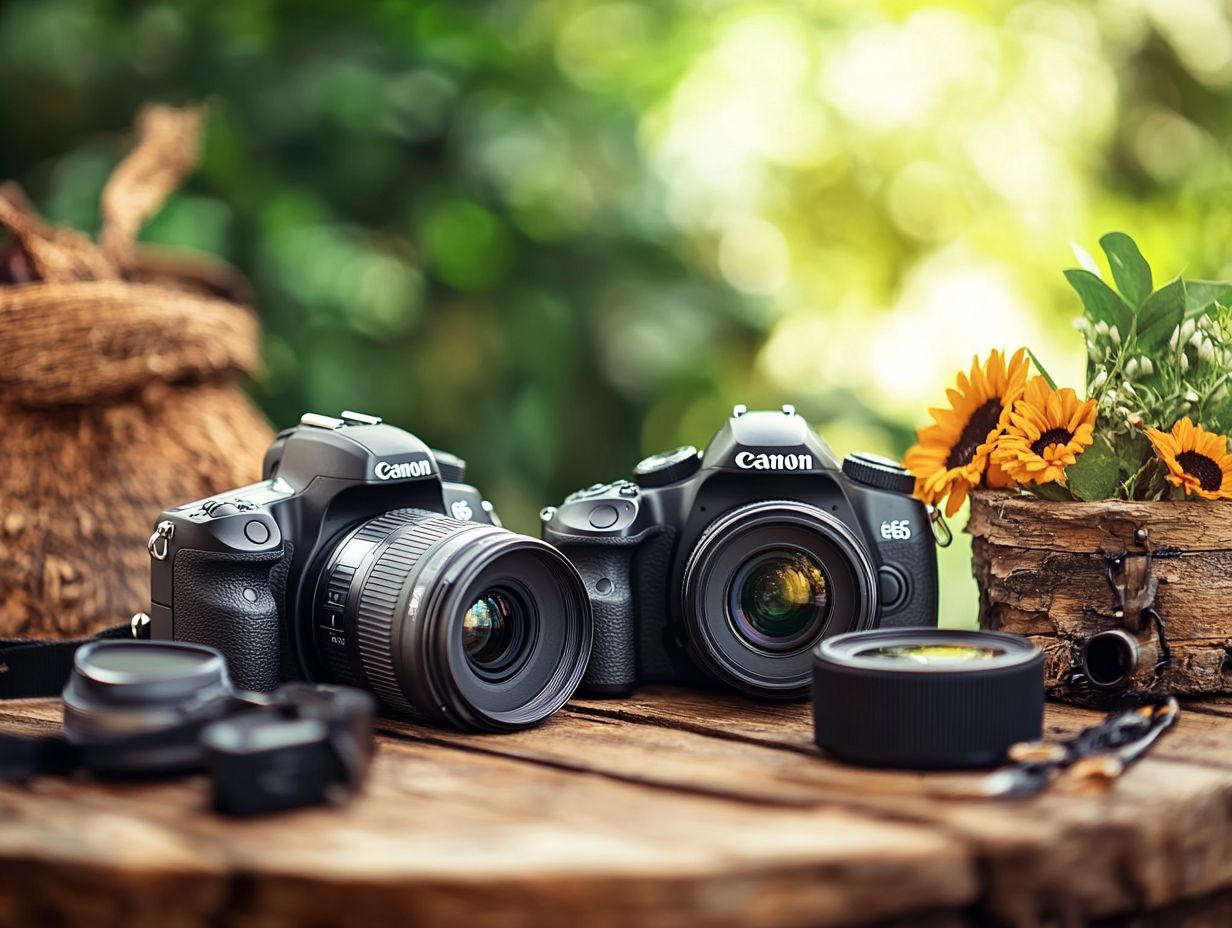
- Consider features such as zoom, autofocus, and burst mode (which lets you take many pictures in a short time) when choosing an affordable camera for bird photography.
- Don’t overlook budget-friendly brands like Nikon and Canon for quality bird photography cameras.
- Practice and learn from mistakes to improve your skills, regardless of your camera’s price.
2. Factors to Consider When Choosing a Camera for Bird Photography
When selecting a camera for bird photography, many things to consider will help you find the best fit. You’ll want to focus on camera bodies and lenses, particularly telephoto reach for those elusive distant birds.
For beginners, a DSLR or mirrorless camera paired with a good telephoto lens can significantly enhance your ability to capture clear, detailed images of birds in flight. Fast autofocus is a must, enabling you to quickly lock onto moving subjects, while burst shooting capabilities let you capture multiple frames per second, increasing your chances of that perfect shot.
Whether you’re a seasoned photographer or just beginning your journey, investing in a well-chosen combination of body and lens that includes these features can elevate your wildlife photography. With the right equipment, you’ll create stunning images that truly highlight the beauty and grace of avian subjects.
3. Top 5 Affordable Cameras for Bird Photography
Choosing the right camera doesn’t have to break the bank. Here are the top 5 affordable cameras that shine in bird photography, including the best compact cameras for bird enthusiasts, perfect for beginners or those on a budget-friendly wildlife photography journey.
These models strike a delightful balance between quality and affordability, showcasing impressive specifications that make capturing fleeting moments of avian beauty a cinch, especially when using photography gear essentials for birdwatching.
Take the Nikon D3300, for instance; its 24.2 MP sensor delivers excellent image detail, and easy-to-navigate controls make it an ideal companion for novice photographers.
The Nikon D7200 enhances your experience with a robust 51-point autofocus system and superior ISO capabilities, perfect for low-light shooting adventures.
Then there’s Canon’s EOS 1300D, featuring a user-friendly interface and built-in Wi-Fi, allowing you to effortlessly share your captivating shots.
The EOS 700D, with its versatile swivel touchscreen, adapts beautifully for unique angles and is compatible with an extensive range of lenses. All of these cameras are excellent choices as you explore the vibrant world of bird photography.
4. Why These Cameras Stand Out for Bird Photography!
Understanding the key features and benefits of each camera is essential for you as a photographer, especially in bird photography where lens quality, fast autofocus, and vibration reduction can dramatically affect your results.
Opting for a camera with superior lens quality enables you to capture sharper, more vibrant images, highlighting intricate details of feathers and plumage. The advantages of a robust telephoto reach are apparent when photographing birds from a distance, ensuring you don t disturb their natural behavior.
Vibration reduction technologies are vital for minimizing the risk of blurry images, particularly when navigating the unpredictable conditions of wildlife photography. Cameras equipped with these features empower you to achieve remarkable clarity and stability, resulting in stunning shots that showcase the magnificence of avian life.
5. Sample Images Taken with Each Camera
To truly appreciate what these affordable cameras can do, dive into these stunning samples!
These photographs vividly showcase their performance in real-world bird photography scenarios. You’ll see intricate details of various species in their natural habitats, capturing not only the birds vibrant plumage but also the stunning environments they inhabit.
Each camera underwent testing under a range of lighting conditions, from the warm glow of the golden hour to the cooler, softer tones of overcast days.
In this exploration, high-quality shots demonstrate how features like advanced autofocus systems and high dynamic range (HDR), which helps capture details in both bright and dark areas, are key to capturing clear images and achieving stunning clarity and color accuracy essential for capturing those fleeting moments in avian life.
By examining each image’s crispness and detail, you can truly evaluate the value these models contribute to your photography adventures.
6. Additional Equipment and Accessories for Bird Photography
Selecting the right camera is just the beginning for bird photography; investing in additional equipment and accessories like high-quality tripods and high-capacity SD memory cards from trusted brands like SanDisk and Transcend elevates your photography experience to a whole new level of seamless productivity.
A sturdy tripod is essential for maintaining stability, especially when you re wielding telephoto lenses that amplify even the slightest shake. This ensures that you capture sharper, more detailed images of those elusive avian subjects.
The importance of this stability becomes even more pronounced in challenging lighting conditions or when photographing birds in motion; it can truly make the difference between a breathtaking shot and a mere blur.
These high-capacity SD memory cards ensure you never run out of space during those thrilling birding moments! They provide ample storage and fast write speeds, allowing you to capture exhilarating bursts of shots that often come with dynamic birding moments, all without the stress of losing those precious high-resolution images.
7. Tips and Techniques for Capturing Great Bird Photos
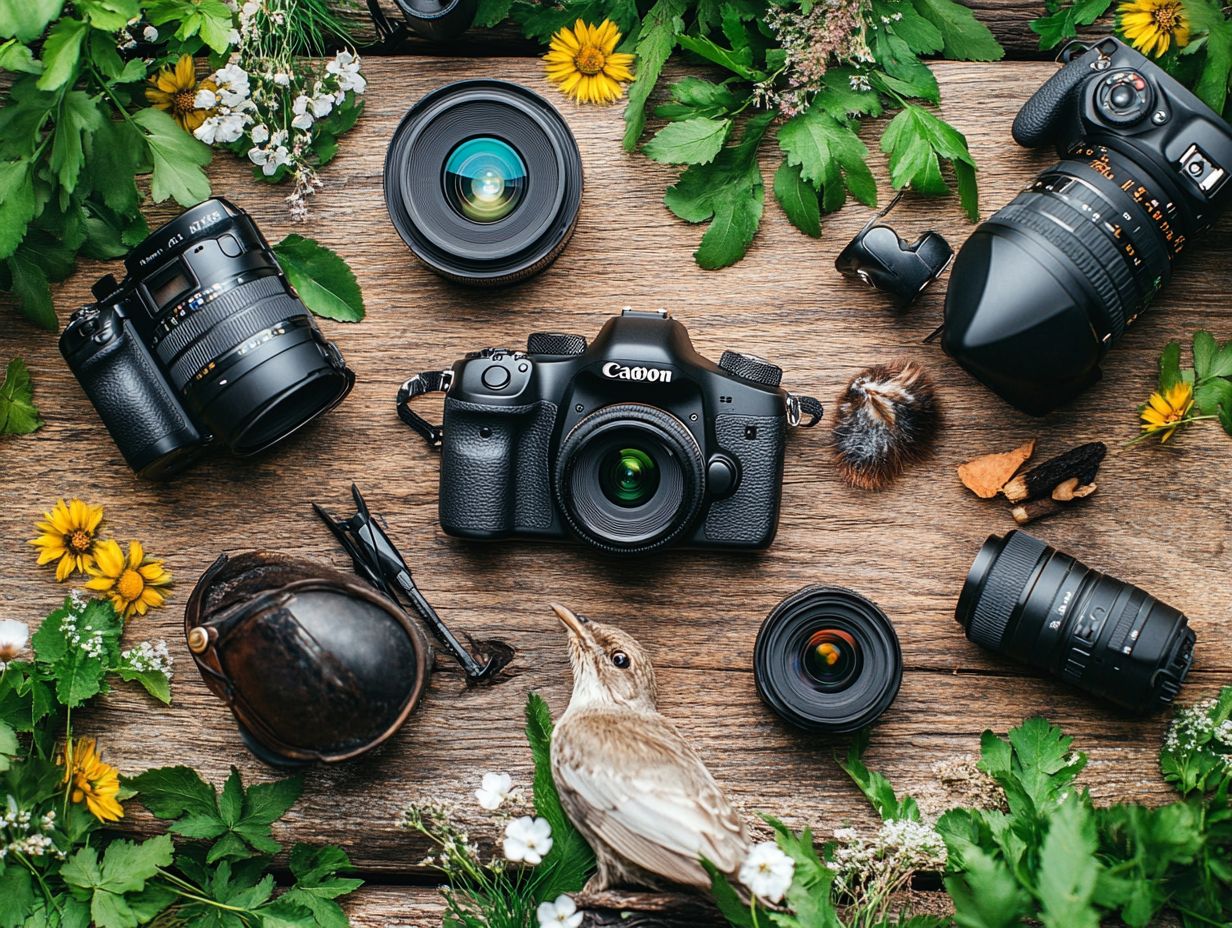
Developing essential photography skills and mastering specific techniques are crucial for capturing stunning bird photography that not only highlights the beauty of your avian subjects but also showcases your prowess as a photographer.
Equipping yourself with the right camera settings is paramount; utilizing fast autofocus will greatly enhance your chances of capturing sharp images, especially since birds are often in constant motion.
The early morning or late afternoon provides the best natural light for your shoots, creating a magical ambiance while ensuring your subjects are active and lively.
Composition matters significantly as well consider the rule of thirds to craft visually appealing images, and pay attention to the background to avoid distractions.
Approaching birds quietly and patiently can dramatically increase your chances of success; leverage natural cover to minimize disturbance to these delicate creatures as you strive to seize that perfect shot.
8. How to Edit and Enhance Bird Photos
Editing and enhancing your bird photos through post-processing techniques can transform your images from ordinary to extraordinary, enabling you to showcase the vibrant colors and intricate details of your subjects.
With the right tools at your disposal, you can turn your captures into stunning visuals that truly reflect the beauty of nature. Popular editing software like Adobe Lightroom and Photoshop offers powerful features tailored for refining images.
Essential post-processing techniques, such as cropping, help focus your viewer s attention, while color correction ensures that the hues of the plumage pop with vibrancy. Sharpening enhances fine details, bringing the texture of feathers to life.
For instance, consider a before-and-after comparison of a gray-feathered bird. It can dramatically illustrate how color correction and sharpening reveal the subtle iridescence that might otherwise go unnoticed.
9. Common Mistakes to Avoid in Bird Photography
New photographers often stumble upon common mistakes in bird photography. With the right knowledge and practice, you ll quickly learn to avoid these pitfalls and elevate your skills to capture stunning images.
These errors typically arise from factors like incorrect camera settings, inadequate preparation, and a misunderstanding of bird behavior. Such issues can lead to frustrating experiences and missed opportunities. For example, forgetting to adjust the shutter speed for fast-moving birds or not using the appropriate lens can seriously hinder your ability to seize those fleeting moments.
To effectively navigate these challenges, you must cultivate patience and deepen your understanding of your avian subjects. By observing birds in their natural habitats, you ll learn to anticipate their movements, significantly boosting your chances of nailing that perfect shot.
10. How to Practice and Improve Your Bird Photography Skills
Consistent practice is essential for enhancing your bird photography skills. It enables you to build on your experiences, refine your techniques, and evolve into a more proficient wildlife photographer.
Setting specific goals for each outing gives you a clear focus. Whether it s capturing a particular species or experimenting with new angles, having a target can elevate your photography game.
Engaging in workshops offers you hands-on learning from seasoned photographers. Joining photography groups cultivates a sense of community and shared inspiration. These groups can provide invaluable constructive feedback and helpful tips that can enhance your work.
Don’t hesitate to dive into different settings and gear each experience can lead to incredible shots! Experiment with various equipment, like telephoto lenses, and venture into a range of environments from bustling urban parks to serene remote habitats. This exploration will enhance your adaptability and improve your ability to capture stunning images in diverse scenarios.
11. Comparing Affordable Cameras to High-End Options
When you explore the realm of bird photography, weigh the pros and cons of affordable cameras against high-end options. Additionally, investing in high-quality binoculars for bird photography can significantly enhance your ability to capture breathtaking images of avian life.
While budget-friendly models may deliver commendable performance, they often fall short in vital areas like lens quality and autofocus speed. Premium cameras typically boast superior glass construction, resulting in sharper images with richer color fidelity.
Higher-end models track fast-moving birds with advanced autofocus systems, allowing you to excel in the vibrant world of birdwatching. Image stabilization varies significantly; top-tier options often integrate more effective mechanisms, delivering clearer shots even at longer focal lengths.
For dedicated enthusiasts or professional photographers, investing in a higher-end model becomes a worthwhile consideration, especially when pursuing exceptional results in demanding shooting conditions.
What Makes a Camera Ideal for Bird Photography?
An ideal camera for your bird photography endeavors should feature:
- Fast autofocus
- Compatibility with telephoto lenses
- Burst shooting capability this allows you to take several photos in quick succession, increasing your chances of freezing fleeting moments.
- Strong low-light performance many bird activities unfold during dawn or dusk, necessitating a camera that maintains clarity and detail in challenging lighting conditions.
For instance, models such as the Canon EOS R5 and the Nikon Z6 II stand out as excellent choices. They are celebrated for their rapid autofocus systems and impressive ISO ranges. To learn more about selecting the right equipment, check out how to choose a camera for bird watching to find the perfect fit for your bird photography journey!
What Are the Key Features to Look for in a Camera for Bird Photography?
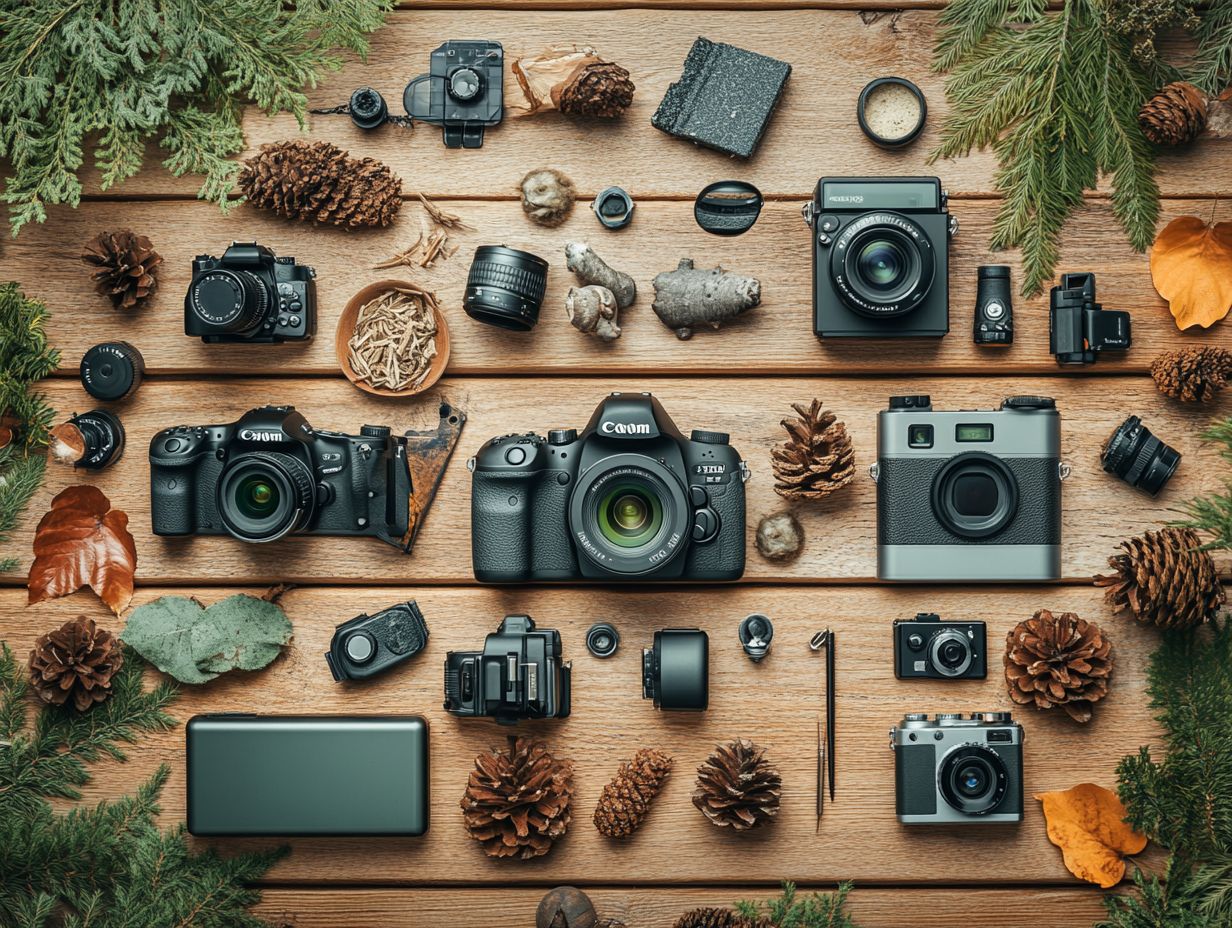
When you re evaluating a camera for bird photography, pay close attention to key features like sensor size, frame rate, and image stabilization. These elements are essential for capturing high-quality images in dynamic environments.
A larger sensor size is your best friend for better low-light performance and greater detail. This makes it easier for you to capture vibrant colors and intricate feather patterns.
Frame rate is equally crucial; it refers to how many images your camera can take in a second. A higher frame rate helps you capture every critical moment, especially when birds take flight or engage in playful antics.
Image stabilization minimizes blur caused by camera shake. Even when you’re shooting handheld, your images remain sharp and clear.
Consider the versatility of a camera that accepts various lenses, especially telephoto options. This enhances your ability to photograph birds from a distance without disturbing them, giving you a closer and clearer view of these majestic creatures in their natural habitat.
What Are Some Budget-Friendly Brands for Bird Photography?
Several budget-friendly brands, such as Nikon, Canon, and Sony, offer outstanding choices for bird photography, including the best water-resistant cameras for birding that don’t skimp on quality or performance.
Take Nikon’s D3500, for example. Its user-friendly interface and lightweight design make it easy to handle during long field sessions.
Or consider Canon’s EOS Rebel T7, which combines excellent image quality with a dual autofocus system. This is perfect for nailing those elusive, fast-moving subjects.
Then there’s Sony s Alpha a6000 series, known for its impressive burst shooting speeds. This allows you to capture action in stunning detail.
Each of these models supports a variety of lenses, ensuring compatibility with accessories like telephoto lenses. These are essential photography accessories for birdwatching, allowing for close-up shots of birds without disturbing their natural behavior, offering solid value for anyone eager to dive into the world of avian photography.
How Can One Get Started in Bird Photography without Breaking the Bank?
Starting your journey into bird photography doesn’t have to break the bank. With the best compact equipment for bird photographers and thoughtful choices, you can jump into this thrilling hobby while keeping expenses in check.
Utilize what you already have and make strategic decisions. For example, your smartphone can be a fantastic starting point; many devices come with impressive cameras and zoom capabilities to help you snap stunning photos.
Exploring local parks or nature reserves offers a vibrant backdrop for your birdwatching adventures. With keen observation, you might capture breathtaking shots of various species in their natural habitats.
Don t overlook the wealth of online resources at your fingertips. Photography forums and instructional videos provide invaluable tips and techniques, allowing you to enhance your skills without financial burden.
What Are Some Common Challenges in Bird Photography and How to Overcome Them?
Bird photography comes with challenges, from unpredictable lighting to the elusive nature of our feathered friends. However, with preparation and insight, you can navigate these hurdles with ease.
Focus on fast autofocus systems that quickly adapt to changing light and movement. Investing in lenses with wide apertures allows more light in, making it easier to capture sharp images during the magical golden hour or in shadowed spots.
Experiment with various shooting techniques burst mode and panning can lead to stunning results. Understanding the behavior and habitats of birds helps you position yourself strategically, boosting your chances of snagging that perfect shot.
Adjusting your ISO settings and employing noise reduction techniques are essential for enhancing image quality in diverse environments.
How Can One Make the Most of Their Affordable Camera for Bird Photography?
Making the most of your affordable camera for bird photography requires a keen understanding of its capabilities and limitations. This knowledge gives you the power to enhance your skills and, when paired with the best camera bags for bird photographers, capture stunning images.
Familiarizing yourself with essential settings, like adjusting the ISO for brighter shots in low light, will enhance your photography. Adjust the shutter speed to freeze fast-moving birds in action for even better results.
Composition plays a critical role, too; applying the rule of thirds can significantly boost the visual appeal of your shots. Don t hesitate to experiment with different focal lengths for fresh perspectives.
Exploring various techniques, such as burst mode or manual focus, will let you seize those incredible moments with ease! Embracing trial and error in diverse environments will refine your skills, revealing the best practices for capturing those elusive feathered friends.
Frequently Asked Questions
What are some affordable cameras for bird photography?
- Nikon D3500
- Canon EOS Rebel T7
- Sony Alpha a6000
Some options for affordable cameras for bird photography include the Nikon D3500, Canon EOS Rebel T7, and Sony Alpha a6000. Additionally, consider checking out affordable lenses for bird photography enthusiasts to enhance your shots.
What is the best budget-friendly camera for capturing birds in flight?
The Nikon COOLPIX B500 is a great budget-friendly camera for capturing birds in flight, especially when paired with the best bird photography gear for beginners, featuring its 40x optical zoom and continuous shooting at high speed.
Do I need a long lens for bird photography?
Having a long lens is highly recommended for bird photography, as it allows you to capture birds from a distance without disturbing them. A telephoto lens with at least 300mm focal length is ideal.
What is the advantage of using a mirrorless camera for bird photography?
Mirrorless cameras are smaller and lighter than DSLR cameras, making them more portable for outdoor photography. They also have fast autofocus and continuous shooting, which are essential for capturing birds in action.
Are there any affordable cameras with good image quality for bird photography?
Yes, the Canon PowerShot SX740 HS is a compact camera with a 40x optical zoom and 4K video capabilities, making it a great option for bird photography with good image quality at an affordable price.
Do I need any special features on a camera for bird photography?
While not necessary, some useful features for bird photography include a fast continuous shooting mode, a tilting or articulating screen, and a high-resolution viewfinder. These features can help you capture birds in action and compose your shots more easily.
Grab your camera and head outdoors those feathered friends are waiting for you to capture their beauty!

